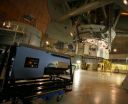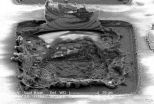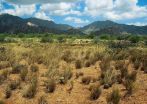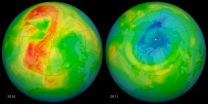(Press-News.org) Researchers have conducted a remote reconnaissance of a distant solar system with a new telescope imaging system that sifts through the blinding light of stars. Using a suite of high-tech instrumentation and software called Project 1640, the scientists collected the first chemical fingerprints, or spectra, of this system's four red exoplanets, which orbit a star 128 light years away from Earth. A detailed description of the planets—showing how drastically different they are from the known worlds in the universe—was accepted Friday for publication in The Astrophysical Journal.
"An image is worth a thousand words, but a spectrum is worth a million," said lead author Ben R. Oppenheimer, associate curator and chair of the Astrophysics Department at the American Museum of Natural History.
Oppenheimer is the principal investigator for Project 1640, which uses the Hale telescope at the Palomar Observatory in California. The project involves researchers from the California Institute of Technology, NASA's Jet Propulsion Laboratory, Cambridge University, New York University, and the Space Telescope Science Institute, in addition to Oppenheimer's team at the Museum.
The planets surrounding the star of this study, HR 8799, have been imaged in the past. But except for a partial measurement of the outermost planet in the system, the star's bright light overwhelmed previous attempts to study the planets with spectroscopy, a technique that splits the light from an object into its component colors—as a prism spreads sunlight into a rainbow. Because every chemical, such as carbon dioxide, methane, or water, has a unique light signature in the spectrum, this technique is able to reveal the chemical composition of a planet's atmosphere.
"In the 19th century it was thought impossible to know the composition of stars, but the invention of astronomical spectroscopy has revealed detailed information about nearby stars and distant galaxies," said Charles Beichman, executive director of the NASA Exoplanet Science Institute at the California Institute of Technology. "Now, with Project 1640, we are beginning to turn this tool to the investigation of neighboring exoplanets to learn about the composition, temperature, and other characteristics of their atmospheres."
With this system, the researchers are the first to determine the spectra of all four planets surrounding HR 8799. "It's fantastic to nab the spectra of four planets in a single observation," said co-author Gautam Vasisht, an astronomer at the Jet Propulsion Laboratory.
The results are "quite strange," Oppenheimer said. "These warm, red planets are unlike any other known object in our universe. All four planets have different spectra, and all four are peculiar. The theorists have a lot of work to do now."
One of the most striking abnormalities is an apparent chemical imbalance. Basic chemistry predicts that ammonia and methane should naturally coexist in varying quantities unless they are in extremely cold or hot environments. Yet the spectra of the HR 8799 planets, all of which have "lukewarm" temperatures of about 1000 Kelvin (1340 degrees Fahrenheit), either have methane or ammonia, with little or no signs of their chemical partners. Other chemicals such as acetylene, previously undiscovered on any exoplanet, and carbon dioxide may be present as well.
The planets also are "redder," meaning that they emit longer wavelengths of light, than celestial objects with similar temperatures. This could be explained by significant but patchy cloud cover on the planets, the authors say.
With 1.6 times the mass and five times the brightness, HR 8799 itself is very different from our Sun. The brightness of the star can vary by as much as 8 percent over a period of two days and produces about 1,000 times more ultraviolet light than the Sun. All of these factors could impact the spectral fingerprints of the planets, possibly inducing complex weather and sooty hazes that could be revealed by periodic changes in the spectra. More data is needed to further explore this solar system's unusual characteristics.
"The spectra of these four worlds clearly show that they are far too toxic and hot to sustain life as we know it," said co-author Ian Parry, a senior lecturer at the Institute of Astronomy, Cambridge University. "But the really exciting thing is that one day, the techniques we've developed will give us our first secure evidence of the existence of life on a planet outside our solar system."
In addition to revealing unique planets, the research debuts a new capability to observe and rapidly characterize exoplanetary systems in a routine manner, something that has eluded astronomers until now because the light that stars emit is tens of millions to billions of times brighter than the light given off by planets. This makes directly imaging and analyzing exoplanets extremely difficult: as Oppenheimer says, "It's like taking a single picture of the Empire State Building from an airplane that reveals the height of the building as well as taking a picture of a bump on the sidewalk next to it that is as high as a couple of bacteria."
Project 1640 helps scientists clear this hurdle by sharpening and darkening a star's light. This technical advance involves the coordinated operation of four major instruments: the world's most advanced adaptive optics system, which can make millions of tiny adjustments to the device's two 6-inch mirrors every second; a coronagraph that optically dims the star but not other celestial objects in the field of view; an imaging spectrograph that records 30 images in a rainbow of colors simultaneously; and a specialized wave front sensor that distinguishes between residual starlight that sneaks through the coronagraph and the light from planets, allowing scientists to filter out background starlight more effectively.
Altogether, the project has produced images of celestial objects 1 million to 10 million times fainter than the star at the center of the image, with only an hour of observations. It is also capable of measuring orbital motion of objects.
"Astronomers are now able to monitor cloudy skies on extrasolar planets, and for the first time, they have made such observations for four planets at once," said Maria Womack, program director for the Division of Astronomical Sciences at the National Science Foundation. "This new ability enables astronomers to now make comparisons as they track the atmospheres, and maybe even weather patterns, on the planets."
Researchers are already collecting more data on this system to look for changes in the planets over time, as well as surveying other young stars. During its three-year survey at Palomar, which started in June 2012, Project 1640 aims to survey 200 stars within about 150 light years of our solar system.
"The variation in the spectra of the four planets is really intriguing," said Didier Saumon, an astronomer at Los Alamos National Laboratory who was not involved in this study. "Perhaps this shouldn't be too surprising, given that the four gaseous planets of the solar system are all different. The hundreds of known exoplanets have forced us to broaden our thinking, and this new data keeps pushing that envelope."
INFORMATION:
This work is supported by the National Science Foundation (grant numbers AST-0215793, 0334916, 0520822, 0619922, 0804417, 1039790, and 1245018), NASA Origins of the Solar System Grant (number NMO7100830/102190), and the Plymouth Hill foundation. Additional funding sources for Project 1640 are listed here.
Astronomers conduct first remote reconnaissance of another solar system
Project 1640 reveals chemical composition of four red expplanets 128 light years away
2013-03-12
ELSE PRESS RELEASES FROM THIS DATE:
Creating indestructible self-healing circuits
2013-03-12
PASADENA, Calif.—Imagine that the chips in your smart phone or computer could repair and defend themselves on the fly, recovering in microseconds from problems ranging from less-than-ideal battery power to total transistor failure. It might sound like the stuff of science fiction, but a team of engineers at the California Institute of Technology (Caltech), for the first time ever, has developed just such self-healing integrated chips.
The team, made up of members of the High-Speed Integrated Circuits laboratory in Caltech's Division of Engineering and Applied Science, ...
Epigenetics mechanism may help explain effects of mom's nutrition on her children's health
2013-03-12
This press release is available in Spanish.
Pioneering studies by U. S. Department of Agriculture-funded research molecular geneticist Robert A. Waterland are helping explain how the foods that soon-to-be-moms eat in the days and weeks around the time of conception—or what's known as periconceptional nutrition–may affect the way genes function in her children, and her children's health.
In an early study, Waterland and co-investigators examined gene function of 50 healthy children living in rural villages in the West African nation of The Gambia. The study has shaped ...
Study shows how one insect got its wings
2013-03-12
COLUMBUS, Ohio – Scientists have delved deeper into the evolutionary history of the fruit fly than ever before to reveal the genetic activity that led to the development of wings – a key to the insect's ability to survive.
The wings themselves are common research models for this and other species' appendages. But until now, scientists did not know how the fruit fly, Drosophila melanogaster, first sprouted tiny buds that became flat wings.
A cluster of only 20 or so cells present in the fruit fly's first day of larval life was analyzed to connect a gene known to be active ...
Study predicts lag in summer rains over parts of US and Mexico
2013-03-12
A delay in the summer monsoon rains that fall over the southwestern United States and northwestern Mexico is expected in the coming decades according to a new study in the Journal of Geophysical Research. The North American monsoon delivers as much as 70 percent of the region's annual rainfall, watering crops and rangelands for an estimated 20 million people.
"We hope this information can be used with other studies to build realistic expectations for water resource availability in the future," said study lead author, Benjamin Cook, a climate scientist with joint appointments ...
Study shows on-pump bypass comparable to off-pump at year mark
2013-03-12
SAN FRANCISCO (March 11, 2013) — Patients who underwent heart bypass surgery without a heart- lung machine did as well one year later as patients whose hearts were connected to a pump during surgery in a study presented today at the American College of Cardiology's 62nd Annual Scientific Session.
CORONARY, an international, multicenter trial of on-pump (with a heart-lung machine) versus off-pump bypass surgery, enrolled 4,752 patients already scheduled to undergo a bypass procedure. The study is the largest to compare the two approaches.
For the primary endpoint of ...
University of Maryland School of Medicine discovers adaptations to explain strategies for survival on Mars
2013-03-12
Research from the University of Maryland School of Medicine has revealed key features in proteins needed for life to function on Mars and other extreme environments. The researchers, funded by NASA, studied organisms that survive in the extreme environment of Antarctica. They found subtle but significant differences between the core proteins in ordinary organisms and Haloarchaea, organisms that can tolerate severe conditions such as high salinity, desiccation, and extreme temperatures. The research gives scientists a window into how life could possibly adapt to exist on ...
Similar outcomes in older patients with on- or off-pump bypass
2013-03-12
SAN FRANCISCO (March 11, 2013) — Older patients did as well after undergoing coronary bypass surgery off-pump as they did with the more costly "on-pump" procedure using a heart-lung machine to circulate blood and oxygen through the body during surgery, according to research presented today at the American College of Cardiology's 62nd Annual Scientific Session.
This large, multicenter trial—the German Off-Pump Coronary Artery Bypass Grafting in Elderly Patients, called GOPCABE—was the first to evaluate on-pump versus off-pump bypass surgery among patients aged 75 or older. ...
NASA pinpoints causes of 2011 Arctic ozone hole
2013-03-12
A combination of extreme cold temperatures, man-made chemicals and a stagnant atmosphere were behind what became known as the Arctic ozone hole of 2011, a new NASA study finds.
Even when both poles of the planet undergo ozone losses during the winter, the Arctic's ozone depletion tends to be milder and shorter-lived than the Antarctic's. This is because the three key ingredients needed for ozone-destroying chemical reactions —chlorine from man-made chlorofluorocarbons (CFCs), frigid temperatures and sunlight— are not usually present in the Arctic at the same time: the ...
NASA's SDO observes Earth, lunar transits in same day
2013-03-12
On March 2, 2013, NASA's Solar Dynamics Observatory (SDO) entered its semiannual eclipse season, a period of three weeks when Earth blocks its view of the sun for a period of time each day. On March 11, however, SDO was treated to two transits. Earth blocked SDO's view of the sun from about 2:15 to 3:45 a.m. EDT. Later in the same day, from around 7:30 to 8:45 a.m. EDT, the moon moved in front of the sun for a partial eclipse.
When Earth blocks the sun, the boundaries of Earth's shadow appear fuzzy, since SDO can see some light from the sun coming through Earth's atmosphere. ...
Angioplasty at hospitals without on-site cardiac surgery safe, effective
2013-03-12
SAN FRANCISCO (March 11, 2013) — Non-emergency angioplasty performed at hospitals without on-site cardiac surgery capability is no less safe and effective than angioplasty performed at hospitals with cardiac surgery services, according to research presented today at the American College of Cardiology's 62nd Annual Scientific Session.
Emergency surgery has become an increasingly rare event following percutaneous coronary intervention (PCI) or angioplasty—a non-surgical procedure used to open narrow or blocked coronary arteries and restore blood flow to the heart. This ...
LAST 30 PRESS RELEASES:
Interaction of climate change and human activity and its impact on plant diversity in Qinghai-Tibet plateau
From addressing uncertainty to national strategy: an interpretation of Professor Lim Siong Guan’s views
Clinical trials on AI language model use in digestive healthcare
Scientists improve robotic visual–inertial trajectory localization accuracy using cross-modal interaction and selection techniques
Correlation between cancer cachexia and immune-related adverse events in HCC
Human adipose tissue: a new source for functional organoids
Metro lines double as freight highways during off-peak hours, Beijing study shows
Biomedical functions and applications of nanomaterials in tumor diagnosis and treatment: perspectives from ophthalmic oncology
3D imaging unveils how passivation improves perovskite solar cell performance
Enriching framework Al sites in 8-membered rings of Cu-SSZ-39 zeolite to enhance low-temperature ammonia selective catalytic reduction performance
AI-powered RNA drug development: a new frontier in therapeutics
Decoupling the HOR enhancement on PtRu: Dynamically matching interfacial water to reaction coordinates
Sulfur isn’t poisonous when it synergistically acts with phosphine in olefins hydroformylation
URI researchers uncover molecular mechanisms behind speciation in corals
Chitin based carbon aerogel offers a cleaner way to store thermal energy
Tracing hidden sources of nitrate pollution in rapidly changing rural urban landscapes
Viruses on plastic pollution may quietly accelerate the spread of antibiotic resistance
Three UH Rainbow Babies & Children’s faculty elected to prestigious American Pediatric Society
Tunnel resilience models unveiled to aid post-earthquake recovery
Satellite communication systems: the future of 5G/6G connectivity
Space computing power networks: a new frontier for satellite technologies
Experiments advance potential of protein that makes hydrogen sulfide as a therapeutic target for Alzheimer’s disease
Examining private equity’s role in fertility care
Current Molecular Pharmacology achieves a landmark: real-time CiteScore advances to 7.2
Skeletal muscle epigenetic clocks developed using postmortem tissue from an Asian population
Estimating unemployment rates with social media data
Climate policies can backfire by eroding “green” values, study finds
Too much screen time too soon? A*STAR study links infant screen exposure to brain changes and teen anxiety
Global psychiatry mourns Professor Dan Stein, visionary who transformed mental health science across Africa and beyond
KIST develops eco-friendly palladium recovery technology to safeguard resource security
[Press-News.org] Astronomers conduct first remote reconnaissance of another solar systemProject 1640 reveals chemical composition of four red expplanets 128 light years away




